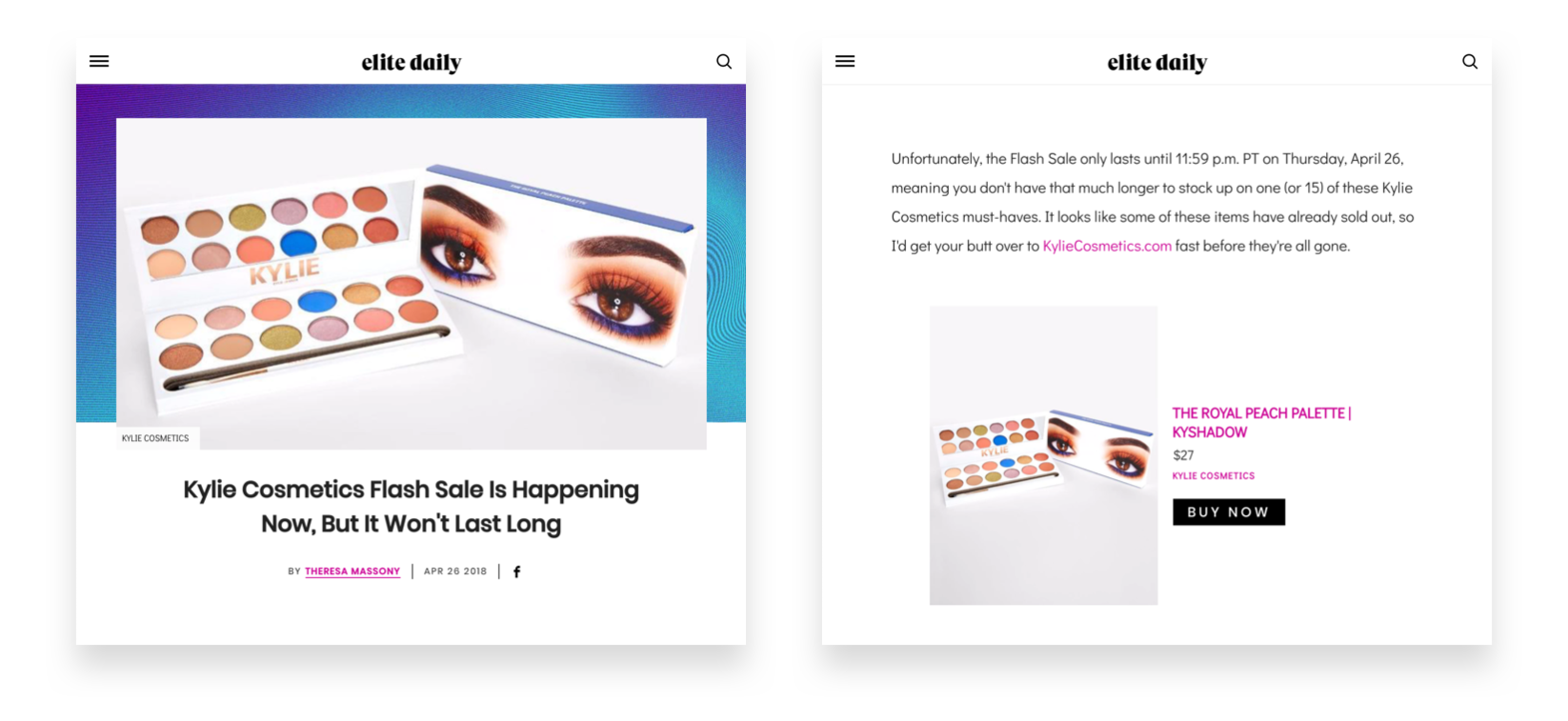- Find out whether a flash sale will help or harm your business, the four reasons they fail, and five best practices for a flash sale strategy
- Discover how to put your next flash sale on “autopilot” with Launchpad
- Learn from real brands about their flash sales—and not just on Black Friday
It’s boom or bust in a very brief sales window.
Whether your brand is dropping an exclusive new product or running a promotion during one of the year's biggest shopping events like Black Friday Cyber Monday (BFCM), many of these transactions will happen in flash sales.
Online sales over the five-day BFCM period topped $28 billion in 2019, with most of the sales happening within a four-hour window on Cyber Monday.
Adobe says these "golden hours of retail" are due to "deal FOMO," the fear of missing out on last-minute deals near the end of the day.
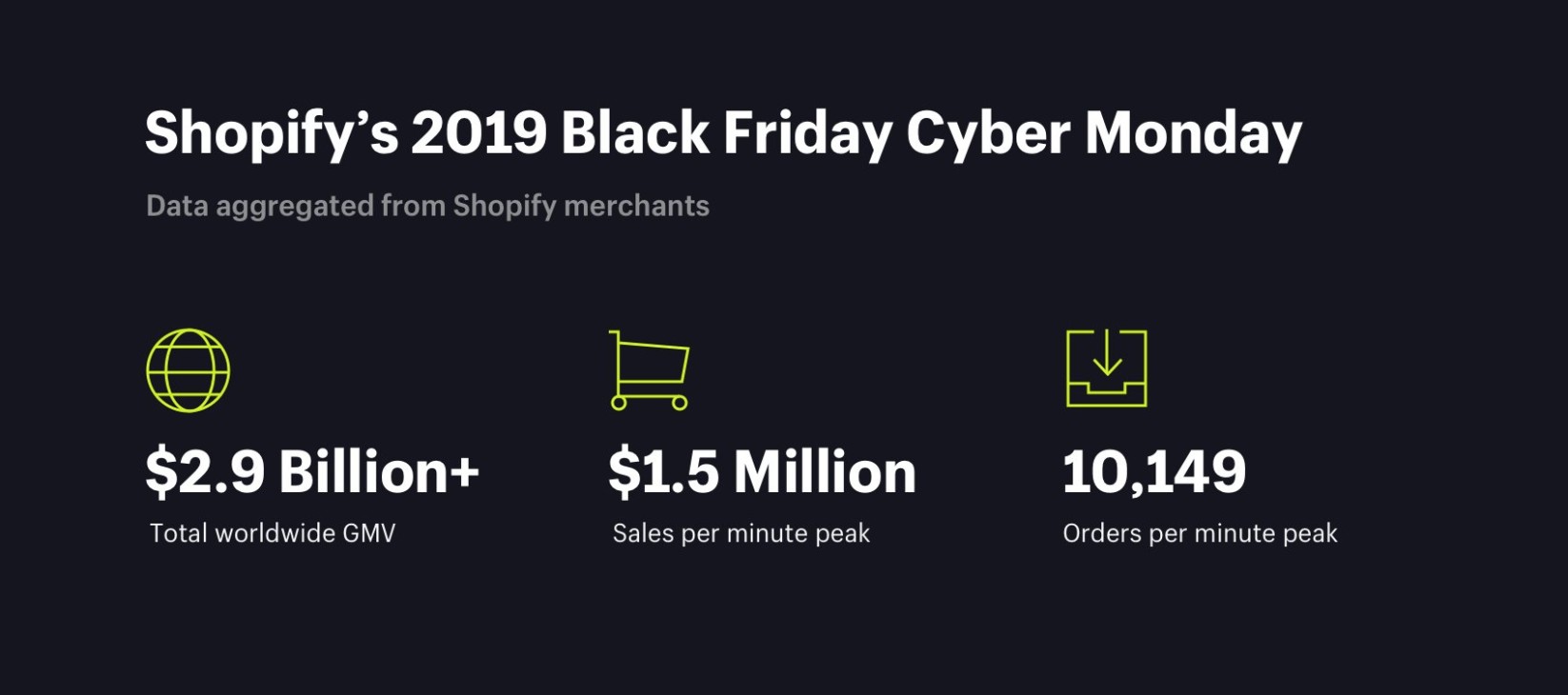
But before you run to drastically slash prices, advertise your sale, and wait for customers to beat down your digital doors, you need to do some planning first:
- What is a flash sale?
- Are you ready to run a flash sale?
- Keep the long-term CLTV in mind
- Reasons why flash sales fail
- The 5 best practices of successful flash sellers ⚡
- Put your next sale on autopilot
- The future of flash sales
- Flash sale FAQs
1. What is a flash sale?
It’s a sale that’s here and then gone in a flash. A flash sale is a discount or promotion offered for a limited period of time. These short-term sales can be great opportunities to sell a large number of products in a few hours, but they require some preparation if you're expecting a large increase in your checkouts. The exclusivity and urgency tap into shoppers' FOMO, which encourages impulse buying.
In most cases, special preparations are only recommended if you're expecting to make more than ten times your usual daily sales within two hours or less.
2. Are you ready to run a flash sale?
There’s no sugar coating it—flash promotions can erode margins and attract bargain hunters with no intention of becoming loyal customers. In a worst-case scenario, failing to deliver on inventory, fulfillment, and shipping promises can destroy your reputation.
But the best-case scenario is well worth the effort. Here’s what top-performing Shopify merchants have seen when they’ve run flash deals. The ROI isn’t just sales—it’s also in brand awareness.
Offering steep discounts for a brief period of time can help grow the bottom line, increase customer lifetime value (CLTV), and earn loyalty you otherwise might not have.
Should you run a flash sale? First, ask yourself if you’re trying to achieve one of the following goals:
- Unload excess inventory
- Acquire customers
- Grow top line
- Lift profits
Flash deals can be effectively used for all of the above.
Gymshark breaks records with flash sales
Several of our retailers have generously agreed to reveal their best flash sale insights so you can optimize your next promotion. One of these brands is Gymshark, a global fitness apparel and accessory brand that has been experimenting with flash sales since it was founded in 2012.
“Flash sales have always been part of the DNA of Gymshark,” says Seb Mills, Gymshark’s Tech Product Director. “From our first Black Friday campaign where we didn’t truly understand the scale of (the holidays) globally, which led to a pretty big shock when we saw the huge wave of traffic and orders.”
Ordinarily, Gymshark executes two flash promotions per year. The company has a summer sale event and a Black Friday Cyber Monday (BFCM) flash event it calls ‘Blackout,’ in which its famously bright and almost over-exposed creative turns black.
“Everything turns dark and black,” says Noel Mack, Gymshark’s Brand Director. “Models wear black on black clothing and we’ll even post completely blank black images on Instagram with no caption to intrigue our consumer. It’s a real departure from our usual content.”
The last Blackout campaign in 2019 broke all of Gymshark’s previous records:
- 9-day campaign
- 650,000 orders in the first 5hrs
- In the first hour sales topped $400,000
- Exceeded the entire 2018 Blackout campaign in just over 4hrs
- 1m unique customers
- 1.1m orders for the campaign
- 13m sessions for the campaign
Mills and his team constantly experiment, adjust, and optimize their flash promotions. It has paid off, as Mills says each sale Gymshark has broken the prior year’s record.
3. Keep the long-term CLTV in mind
Flash deals can yield a steep jump in sales, but profitability isn’t the only (or the best) success metric for your sale's performance. We recommend looking at customer lifetime value (CLTV) as an indicator of whether these sales work for your long-term strategy.
Track your new customers’ flash purchases to see:
- If you’re able to upsell
- If you’re able to cross-sell
- If sale customers become loyal
This piece shows you how to accurately calculate CLTV (among other key metrics):
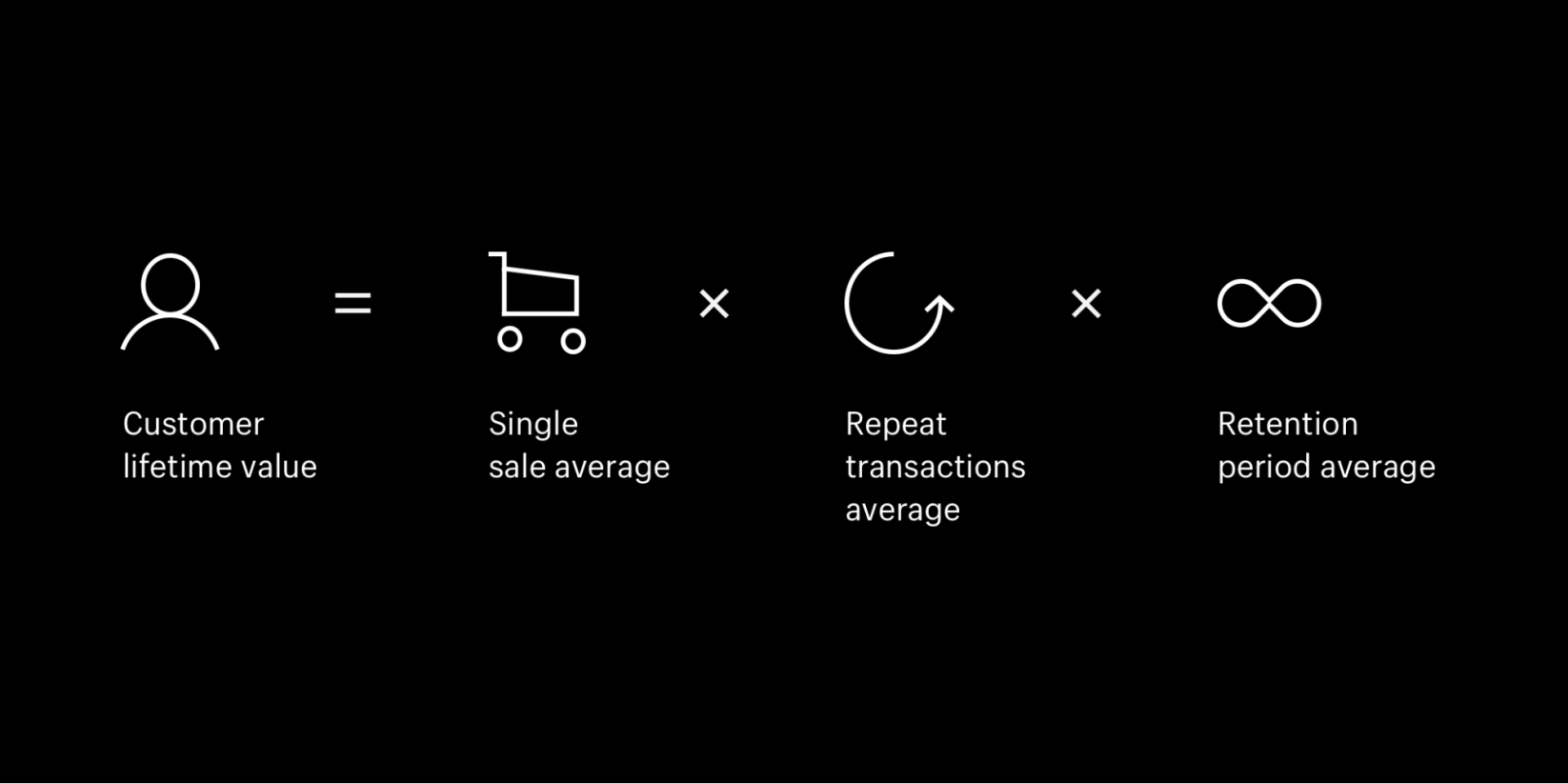
Knowing your CLTV helps gauge the quality of your flash customers. If flash customers compare unfavorably with CLTV, reconsider your sale strategy.
If flash customers compare favorably with CLTV, however, compare flash sales with the costs of other acquisition techniques and balance with top-line growth accordingly.
Research suggests that satisfied customers return to spend another 385% of the first purchase.
4. Reasons why flash sales fail
History is littered with failed flash sales and the corpses of companies built on flash sale business models:
- Totsy liquidated after burning through $34 million
- Fab, once valued at $900 million, now sits at $50 million
- Groupon lost 80% of its market cap in the year following its IPO
- Zulily once had a cap of $7 billion and was acquired for $2.4 billion
- Rue La La, acquired by eBay, was sold because it dragged down profits
We won’t belabor the fact that site crashes are the death knell for many flash deals. They are often the top reason these sales fail. However, flash sale failures are also caused by:
#1: Shipping fail
It’s not uncommon for flash deal customers to complain of waiting several weeks to receive merchandise that arrives in multiple installments.
Customer perception is shaped not only before and during the sale but also by what happens after a purchase is made. Shipping flash-sale items quickly is paramount. Nearly two-thirds of consumers expect their orders to arrive in 1-3 days and more than half want you to offer overnight shipping.
Make your flash deal stand out by offering free shipping. Not only can doing so help you differentiate your brand and better compete with Amazon, but free shipping can also increase your average order value (AOV). Research suggests 48% of consumers are willing to add additional items to their carts to qualify for free shipping.
#2: Inventory fail
According to an ecommerce fulfillment solutions provider, 45% of items sell out faster than expected. One way to really disappoint customers is to build excitement, use scarcity to drive them onsite, and then tell them the item they want is out of stock.
“Yes, we ensure we have plenty of stock before running flash sales,” says Brian Lim, Founder and CEO of Emazing Group, a family of lifestyle and self-expression brands. “We have to plan these out months in advance. Another tip is to move these products closer to our packing stations before the sale date to increase efficiency in pick, pack, and ship.”
Not getting the product you were hoping for is deeply disappointing: 43% of respondents in this survey said they don’t like flash deals because they fear being disappointed by not getting the item they want.
Consumers who are disappointed often vent on social media which, in turn, harms your brand. To quantify that, 44% of the more than 2,700 comments studied in a content analysis of Facebook pages run by flash sellers were negative.
Alleviating inventory fail and the associated fallout comes by doing four things:
- Research demand and prepare your supply chain accordingly
- Be transparent about your inventory by adding inventory quantities to your product pages
- Be prepared to say “I’m sorry,” and keep in constant communication with buyers if you mess up
- Embrace scarcity as exclusivity and invite visitors who arrive too late to get notified of your next sale via email or Facebook Messenger
Gymshark’s Mills suggests inventory allocation is also crucial:
“Another learning from years of practice is to make sure stock splits are fully optimized across stores. For us this involves analysis and forecasting of sales in order to determine the percentage split of stock allocated to each store, we also ensure we have adequate buffer stock levels to protect from oversells.”
#3: Bots fail
GQ described the rise of sneaker drops as “lottery tickets,” noting, “[A]s in actual lotteries, people have discovered ways to work the system to their favor. ‘Bots’—computer programs that can work their way to ecommerce checkouts faster than any human—are the most popular hack.”
And it’s not just shoes. Limited edition products from cosmetics to sweatpants to diaper bags have all been hit by the bot invasion. They’ve also plagued deep-discount events and holiday promotions.
The problem is two-fold: First, bots rob loyal customers of the chance to purchase merchandise they genuinely love. Second, bots have also created a thriving resale market online, causing both retailers and fans to suffer.
All you have to do is look at resale sites. Because while those hard-to-get items that were just on flash sale on your site are sold out, within a matter of minutes those same products are available online at huge markups via resellers.
Naturally, your actual customers are frustrated when they miss out on a flash sale from their favorite brand, and many of them will take to social media to complain. They’ll blame you, not the bots or the resellers—and they might even accuse you of being in league with the reseller sites.
Your most passionate customers are waiting for your flash sale, but your brand is letting them down. What can you do to mitigate the bots? As a flash seller, your most significant differentiator will be to level the playing field. If you can slow the bots down long enough (or block them altogether) so that real superfans of your brand can get hold of your merchandise, your brand can avoid the bad press that comes with flash sale drama.
There are several options for outsmarting bots. One solution is to leverage Captcha forms—letter quizzes or picture tests—at checkout. On Shopify Plus, you can easily schedule Bot Protection in your admin ahead of sales events.
A commonly available method is to lock out well known \"product scalping\" bots, and many brands will pay for apps that will stop these bots. This is certainly a useful option, but it’s a lot like playing a game of Whack-a-Mole—you get some bots, but new ones crop up. And for existing bots, it's easy for them to change their server farm or IP address or use a VPN and bypass the lockouts, leaving you back at square one.
Brands on Shopify can now take advantage of bot protection out of the box. With bot protection, brands can greatly reduce the number of bot purchases by blocking known bots from completing a checkout. In addition to that, a checkpoint challenge will significantly reduce the number of unknown bots from purchasing by requiring every buyer to complete a unique challenge and qualify as a human, before they can enter the checkout.
Bot protection will also help eliminate overrun checkouts, since it decreases the number of bots that can enter. We've all experienced long waits to get to the checkout, and our customers hate that as much as we do.
A recent consumer study by Splitit reported that 87% of online shoppers abandon their shopping carts during checkout if the process was too slow or complicated. And 55% of shoppers who abandon carts would vow never to return to the retailer's site. Those numbers can be devastating for your brand over the long term, so bot protection is key to your success as an online flash seller.
#4: Site fail
Even for large brands, flash sales often result in routine site crashes. But if your business model heavily relies on flash sales, load testing your site is a must. The extra server capacity is likely cost-prohibitive during non-flash times.
The ability to scale on demand is necessary to prevent crashes. You can forecast peak transaction loads based on user behavior in response to email marketing, PPC campaigns, and social media traction.
Lastly, be sure your ecommerce platform and any apps or third-party tools that depend on API calls to function are likewise load tested.
A note on failure:
Not all of your flash sale experiments will succeed. What’s important is learning from each attempt and using those insights to run better experiments and sales. Gymshark’s Mills offers this advice:
At Gymshark we very much live by the philosophy of ‘fail fast, learn faster’. One of our biggest learnings when it comes to executing flash sales is not to be overconfident and always have a plan A, B, and C for when things go wrong.
"An example of this for us is having a plan for when things go wrong (i.e., having customer communications already planned out and designed.)"
5. The 5 best practices of successful flash sellers
1. Pick the right time
Brick-and-mortar stores have taught us people will forgo sleep, line up before dawn, and behave in ways they otherwise might not for a great deal. But this doesn’t mean we need to “open the doors” at 4 a.m..
When should you run a flash sale?
That’s the question I asked Greg Merrell of Simplistic—a Shopify Plus Partner that’s not only worked with mega-retailers like Fashion Nova, but also creates one-off flash deal sites to accompany major-media appearances on venues like Good Morning America, Shark Tank, and Ellen.
His answer: “Sorry to disappoint, but we don’t recommend any ‘best-practice’ timetables for scheduling a flash sale,” says Merrell, “just as there are no best-practice timetables for advertising. The schedule is going to depend on your product and target customer.”
That means, look at your analytics and see if any purchasing patterns emerge:
- What day(s) of the week do people historically purchase?
- What time of day do people historically purchase?
- When are your email open rates highest?
Keeping Merrell’s warning in mind, we can suggest some starting points for timing using data from Launchpad—an automation tool for major online events on Shopify Plus that we’ll explore more below:
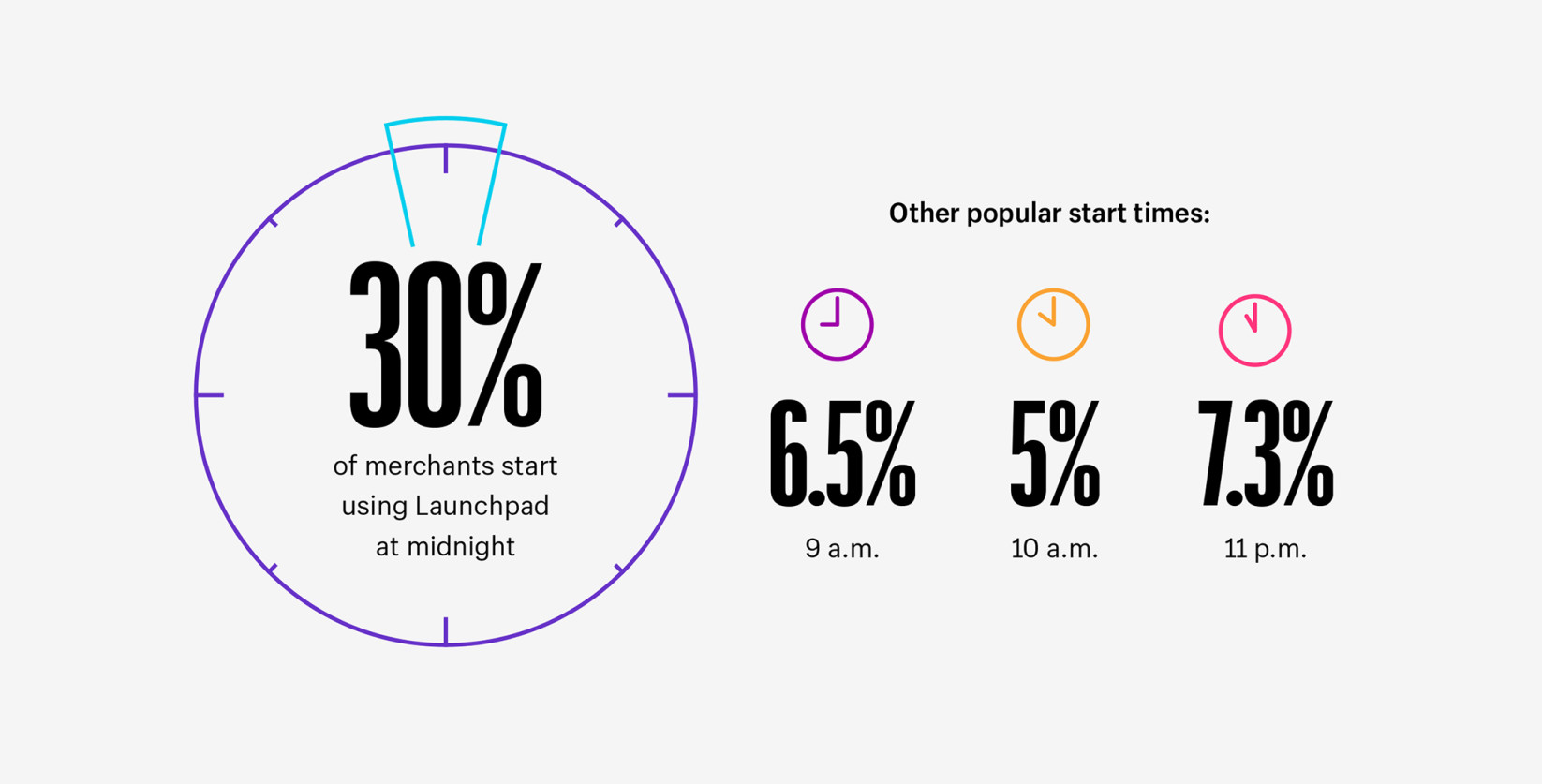
How long should a flash sale last?
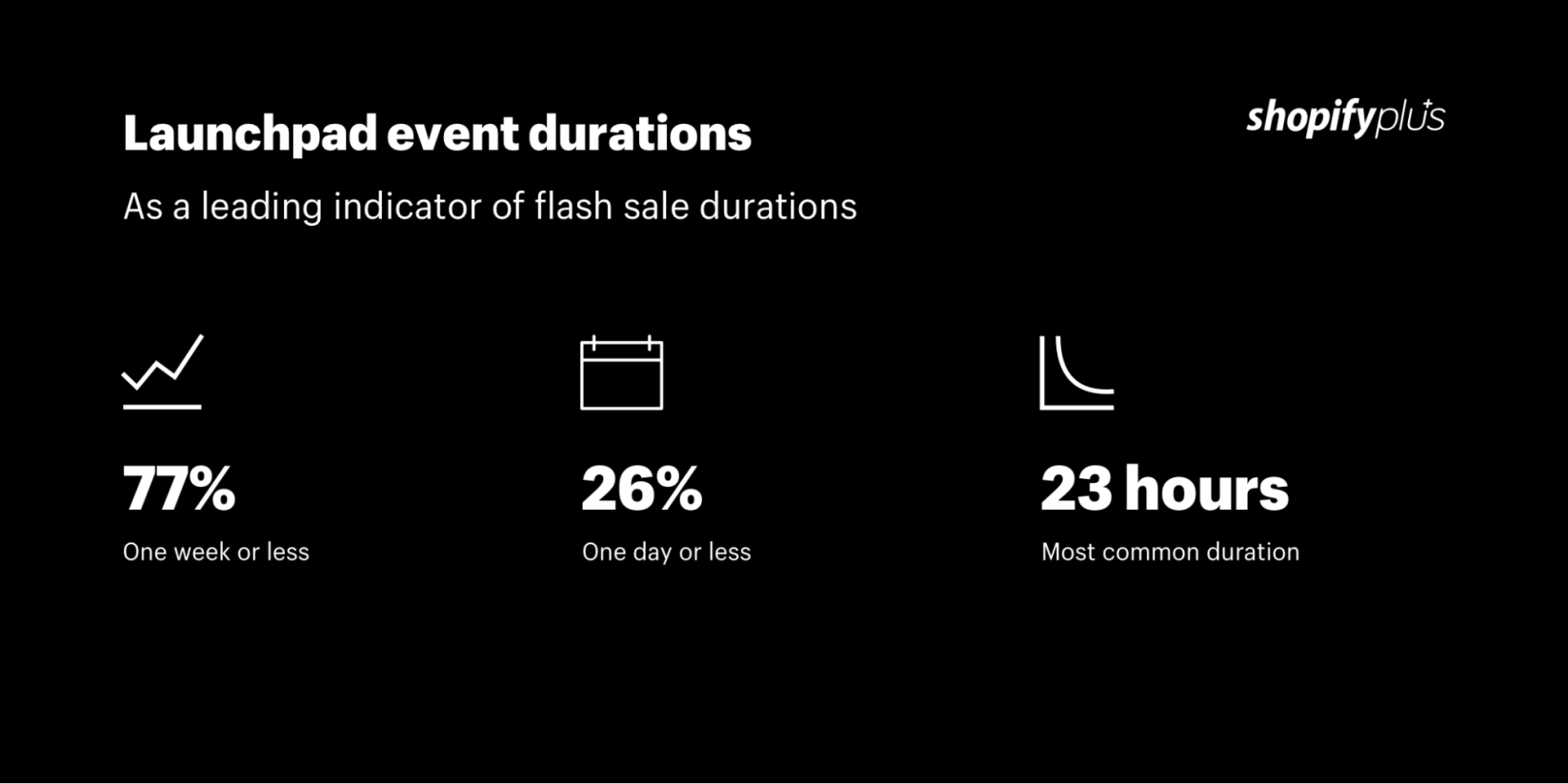
Though some of our brands have flash deals that last days, research suggests shorter is often better:
What time should they end?
Let’s look at the Launchpad data again:
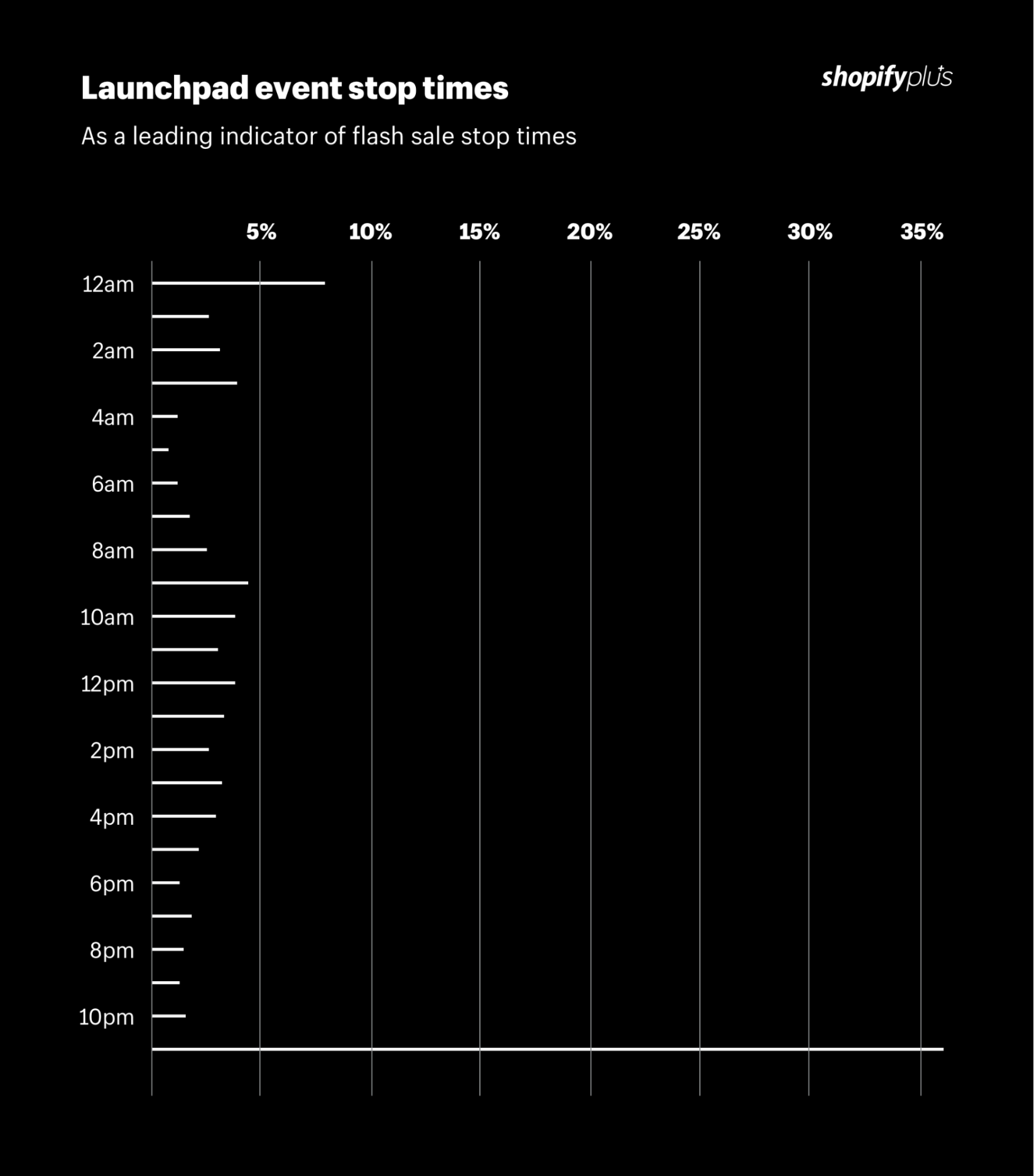
2. Narrowly define your target market
How you define your target market hinges on the goal you set for your flash sale.
- Unload excess inventory
- Acquire customers
- Grow top line
- Lift profits
If the goal is to acquire new customers:
- Don’t overtly market the sale to your existing email list
- Identify consumers who have shown interest in soon-to-be-sale products or who follow a competitor with similar products
- Poach these consumers by targeting competitors’ Facebook audiences or by creating a list of their Twitter handles
- Run limited-time Google Ads that are triggered only by the exact keywords associated with your sale products
- Ask PPC targets to opt into a separate VIP email list in return for early access or some other benefit to offset PPC costs
For instance, Morphe has used Reddit to test and refine its approach:
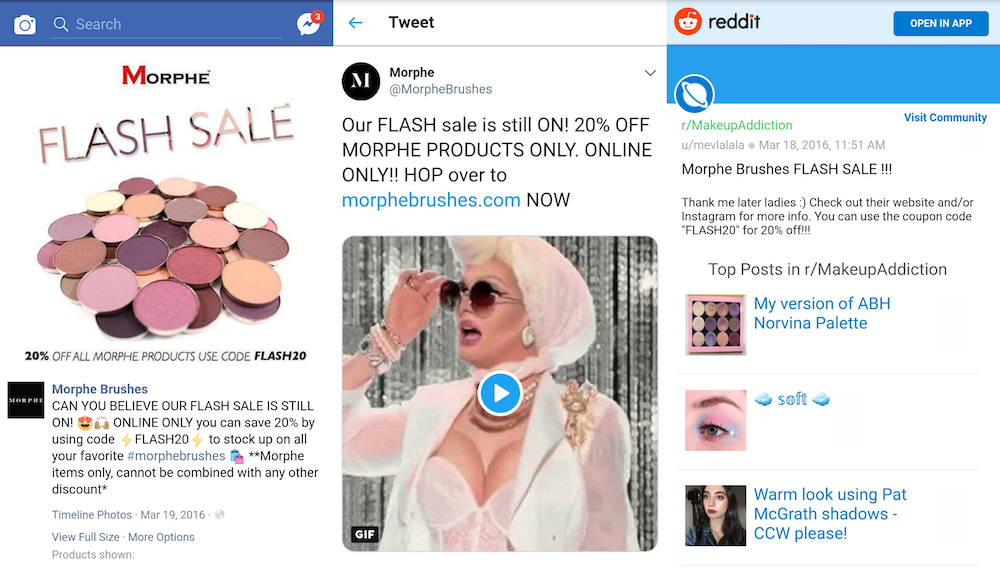
If the goal is to increase profits from existing customers, target customers based on:
- Prior interest in sales or specific products
- Most or least valuable customer profiles
- Inactive customers
Be sure to suppress the segment of your customer base who has already purchased the item you are massively discounting. They won’t be happy when they see their peers are getting the same item 70% off.
Afraid to niche down too much? Keep in mind that the wider you cast your net the lower your conversion rate is likely to be, the higher your CPC, and the lower your ROI.
Mini-flash sales are great ways to test how a larger sale will work—they aren’t characterized by extremely small audience sizes. Instead, they simply use a bit of data intended to narrow the net you cast to improve your KPIs. The more you narrow your target, the better shot you have at generating higher returns.
3. Choose the right products for a successful sale
You may decide to hold a flash deal on your marquee product and be done with it in 2-3 hours without giving it much thought. This might work well and be the only option for an ecommerce company with a skinny catalogue of SKUs.
However, if you’re a retailer with thousands of items—many of which aren’t moving as fast as you’d like—how do you identify the ones that might work best in a flash deal?
- Use Google’s Keyword Planner to identify search volumes
- Identify poor or negative product reviews left by customers of your competitors and poach them with a clever sale ad
- Leverage keyword spy tools like SEMRush and SpyFu to identify which items your competitors are focusing on and undercut them
If your flash sale is to attract new customers:
- Flash sell excess high-margin seasonal inventory to move it quickly and reduce accounting costs
- Start a relationship or poach a competitor’s customer by flash selling popular, low-margin merchandise
- Hold a “secret” and ongoing sale for new customers, promoted through your confirmation email
If your flash sale is aimed at existing customers:
- Select items based on high traffic or low purchase volumes
- Flash sell items only to segments that have expressed some interest in them in the past (visited product page, clicked on an ad, etc.)
- Hold a “secret” and ongoing sale for existing customers, promoted through abandoned-cart emails
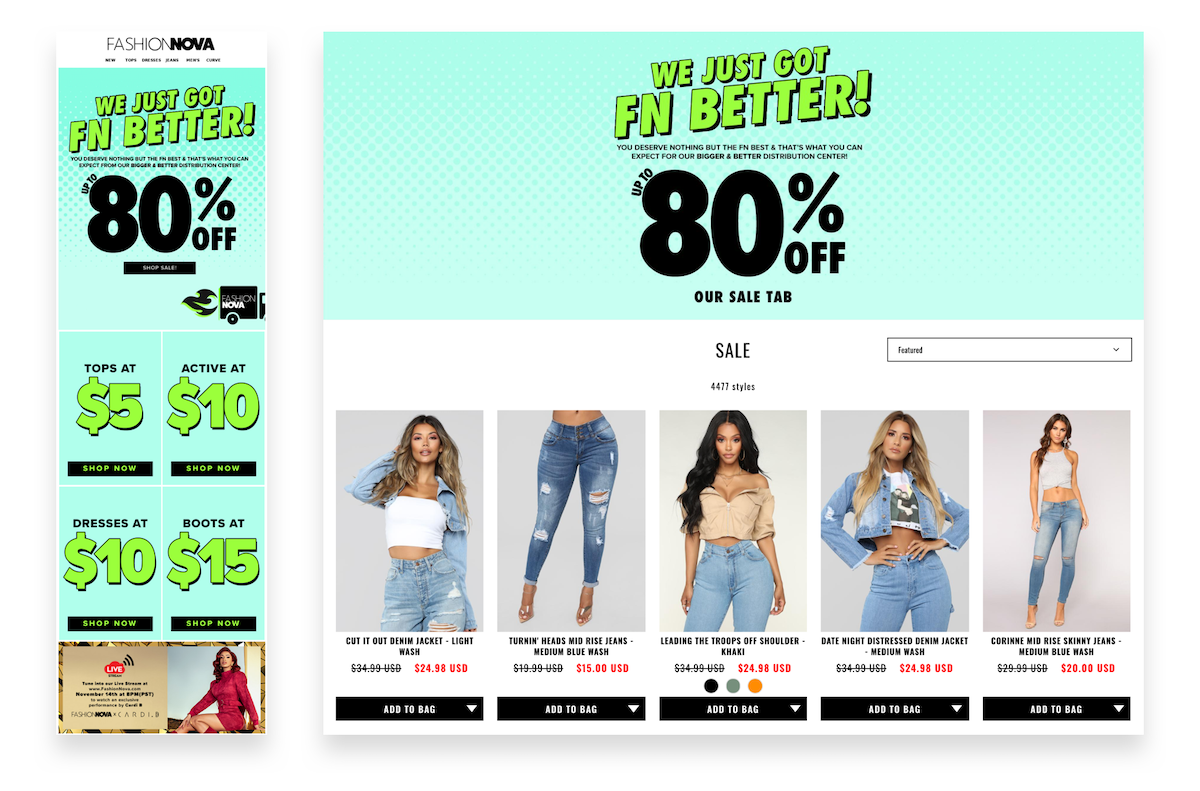
4. Promote scarcity and value
No amount of marketing, however, can save a flash sale unless it combines great merchandise at a deep discount.
It’s why scarcity (quantity and sales length) is a foundation on which you’ll build your marketing mix. For example, consider a "24-hour flash sale" or a "summer flash sale" or even a recurring "flash sale Friday". The key, according to research, is touching people via email shortly before the sale is to begin.
Test to see if PPC ads in the days leading up to a sale generate opt-ins that ensure you have direct last-minute access to prospects. But remember: it’s email that drives the most traffic. In fact, email sent within 24-hours of the start of a sale resulted in a 35% lift in transaction rates.
While it may be the most lucrative, email is just one of the levers you have to pull.
This case study details how Facebook page likes, lookalike audiences, and scrolling product ads that show multiple product images per ad resulted in:
- 81% of flash sales coming from Facebook
- Facebook converting at 2.9% vs 1.45% from other channels
- Facebook’s CPA of $33 dwarfing site-wide CPA of $73
The key to determining which channel is likely to produce the best ROI for you is, as usual, hiding in the data:
- Where do your prospects and customers spend their time?
- What percentage of your marketing currently goes to those channels?
- Which channels yield the highest click-through-rates (CTRs) and conversions as well as lowest customer acquisition costs (CACs)?
Weight your spend according to where and how you’ve had past success selling the items.
Influencers are another channel by which you can effectively promote your sale. In the case of Gymshark, it enlists help from its deep roster of Gymshark athletes. In promoting its Blackout sale, Gymshark used influencers in video marketing. The company provided us with this behind the scenes look:
5. Differentiate your flash sale
You can differentiate your sale in ways that make you stand out and help you predict demand.
Registration flashes
To better gauge demand and ensure you have the inventory and server capacity to withstand the deluge, consider asking people to register for the sale. It’s similar to a traditional auction where you have to provide contact information to receive a bidder’s card.
Not only will you get a ballpark idea of what peak load capacity may look like and how much inventory you may need, but you’ll also position yourself to reduce your PPC spend a bit as you’ll be collecting email addresses for contact purposes as you get closer to the sale.
VIP or early bird flashes
Stimulate user imagination by promising a mystery item to be included in the sale for registered consumers like them. Or, promise a first look or sneak peek at the mystery items shortly before the sale.
This twist achieves many of the same goals registration does but adds a bit of mystery to the scarcity inherent in flash deals. Not only does it ask users to register but it creates a bit of intrigue by keeping secret some or all of the items to be included.
Once again, you’ll position yourself to better gauge demand. You’ll also create a reason for prospects to visit your site prior to the sale—people who otherwise might not have. This provides you rich data about which products users show the most interest in and can help you select which items you designate as mystery items. The data also provides you with retargeting opportunities long after your sale ends.
“As a brand, your job is to know your customer,” says Greg Merrell, “leverage that expertise to provide them with a great offer on something they want at a time that’s appropriate to them.
“A flash sale shouldn’t be an opportunity—or, be perceived to be an opportunity—for you to offload old inventory that you need to liquidate. It should be a reward for your biggest fans and close followers first and foremost. They’re your evangelists and their word of mouth will do a lot to drive additional sales.”
6. Put your next sale on autopilot
Flash deal leaders often automate their events to save time and money. This makes sense since pre-sale to-do lists are lengthy and can include:
- Unhiding products
- Navigation changes
- Landing page updates
- Uploading hero images
- Collection page alterations
- Publishing a new homepage
Manually preparing your site, or building a new one just for the sale, is a time consuming and laborious process that drains resources that could be better spent experimenting for growth or focusing on higher value ROI-generating tasks.
It’s why many brands using Shopify Plus automate their sales with Launchpad, which, as we mentioned above, allows you to easily schedule the components of your sale in advance, coordinate, and automatically execute everything related to your flash sale. Launchpad also allows brands to roll back all of the changes immediately after the sale, and restore their traditional online storefront with just a click of a button.
Flash sale spotlight: Blenders
Blenders, a popular eyewear brand selling polarized shades and ski goggles, is a flash sale leader leveraging the power of automation to 10x sales by instantly switching between flash sales. Blenders used Shopify Plus’ Launchpad to execute two separate site designs: one for its Black Friday flash sale, another for its new promotion on Cyber Monday:
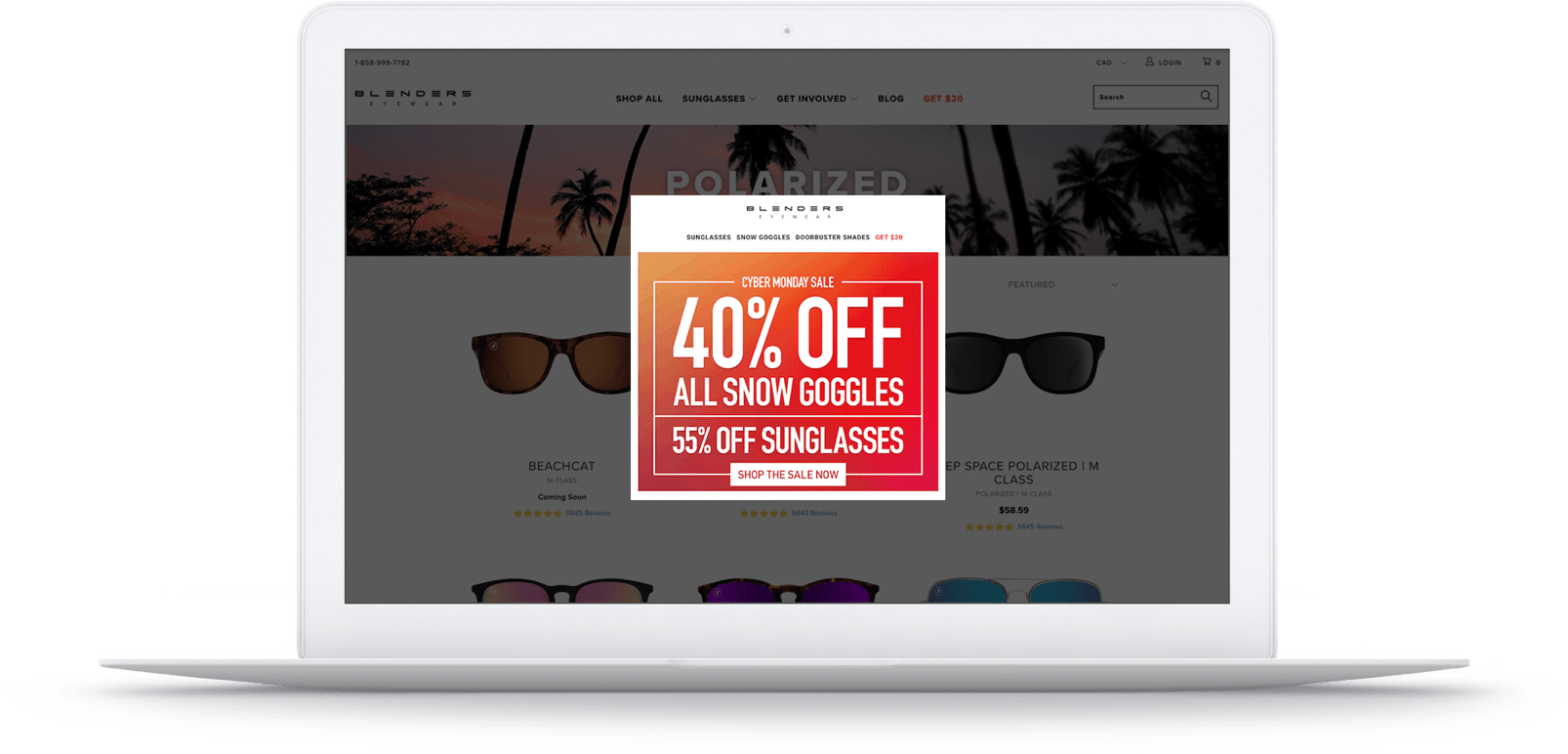
“When things go live at midnight, you don’t want to have to stay up till midnight to do all these changes,” Blenders’ CEO, Chase Fisher, says. “We had our offers switched to go out through Launchpad. We had our themes switched to go out through Launchpad. They pushed everything through successfully.”
Flash sale spotlight: 100% Pure
Before organic cosmetics brand 100% Pure began using Launchpad to put its flash and major sales on autopilot, employees would painstakingly work into the wee hours of the night so as not to disrupt shoppers during normal business hours.
In addition to making 100% Pure more efficient, Launchpad’s live dashboard allows employees to make real-time adjustments that lift sales. Since using Launchpad to automate major sales events 100% Pure is:
- Saving 12 hours per sale or campaign
- Reallocating hundreds of hours a year
- Automating sales and campaigns to fuel 40% YOY growth
“Launchpad saves us a bunch of time,” says engineer Chris Tran. “Instead of doing all of that tedious manual work I can now focus on more important work like mining our analytics to discover patterns that’ll help increase sales.”
7. The future of flash sales
Rather than ask what the future of flash sales might be, it may be more apt to say “Flash is the future.”
We believe flash sales will increasingly help brands forge bonds with customers that can’t be had through other means. The notification and execution happen in real time. The anticipation drives people to show up in droves at a specific time and place. The sale arouses an emotional response and provides a visceral customer experience no competitor can fully replicate.
Next generation flash sales will build on this foundation, and we are working toward making sales fairer, with bot mitigation technology that prevents bots from rapidly purchasing the majority of sale inventory. We want brand loyalists to have an equal or better chance to buy the items they love from the brands they love.
Similarly, we’re also building on the concept of exclusivity, which one day will give merchants the power to better control who gets access to their flash sales.
We envision a flash sale future in which brands are empowered to better predict which customer segments are most likely to participate in flash sales so brands can better personalize the flash sale experience.
The biggest flash sellers in the world trust us when it matters most. To the flash sale leaders who have given us this sacred trust, we thank you. You’ve pushed us to create the world’s best flash sale platform. You’ve forced us to solve the toughest problems. You want and deserve even more though.
We promise to reward you with new flash sale magic in the years to come.
8. Quick review: Flash sale FAQs
Want all of this distilled down to its bare essentials? Hey, we hear you. Here are the answers to your most searched questions.
- What is a flash sale? A discount or promotion offered for a short period of time. This taps into shoppers’ deal FOMO and sense of urgency, encouraging impulse buying.
- What does “flash sale” mean? A big discount sale that happens in a “flash”!
- How do I do a flash sale? That’s a big question with a long, detailed, step-by-step answer. Don’t worry, it’s not hard! But, you do want to make sure you are prepared for high-volume sales and website visitors.
- How long does a flash sale last? Research shows shorter is often better, but three hour flash sales appear to be the sweet spot for best transaction to click rates.
- Are flash sales effective? Short, deep-discount sales are very effective at increasing traffic, conversion rates, and revenue for short-term wins. And, when you do them right, they can increase customer lifetime value as well, for longer term gains.
- Why do companies do flash sales? Offering steep discounts during a small window of time can help grow the bottom line, increase customer lifetime value, and start customer relationships you might not have otherwise.
- How do you win flash sales? Okay, we’re going to loosely translate this search phrase to mean “How do I get the best possible outcomes from my flash sale?” And the answer is this: Don’t treat your sale like a way to get quick cash (though it is). Treat it like a great way to start relationships with new customers who you might not have met otherwise. Give those new customers a great experience with your flash sale so they’ll come back and increase their CLV (customer lifetime value).
- What is a flash sale strategy? One of the keys to flash strategy is to promote the sale well before the limited sale window. Advertise on your social media channels three days to a week in advance, and make sure you include the “great merchandise” you’re selling, and the deep discount you’re selling it for. Because no amount of marketing can save a flash sale unless it combines great merchandise with a deep discount!
- Flash sale examples? Sure thing. Here are some of our favorites.
